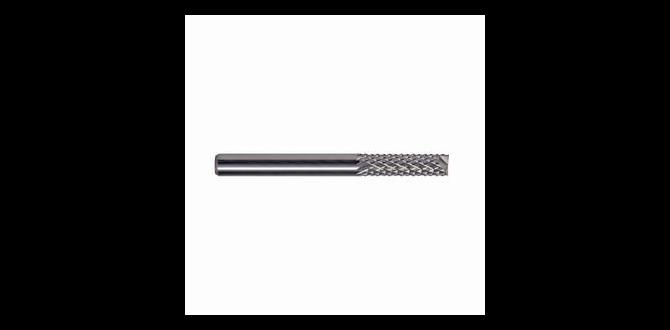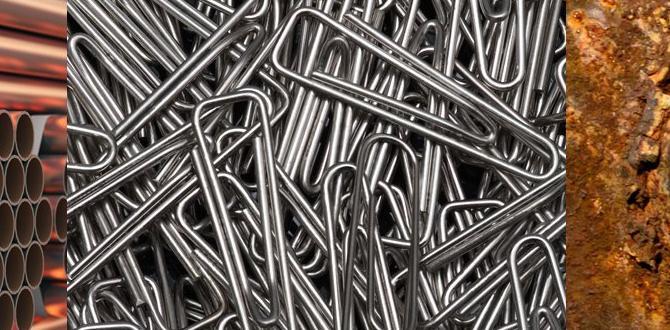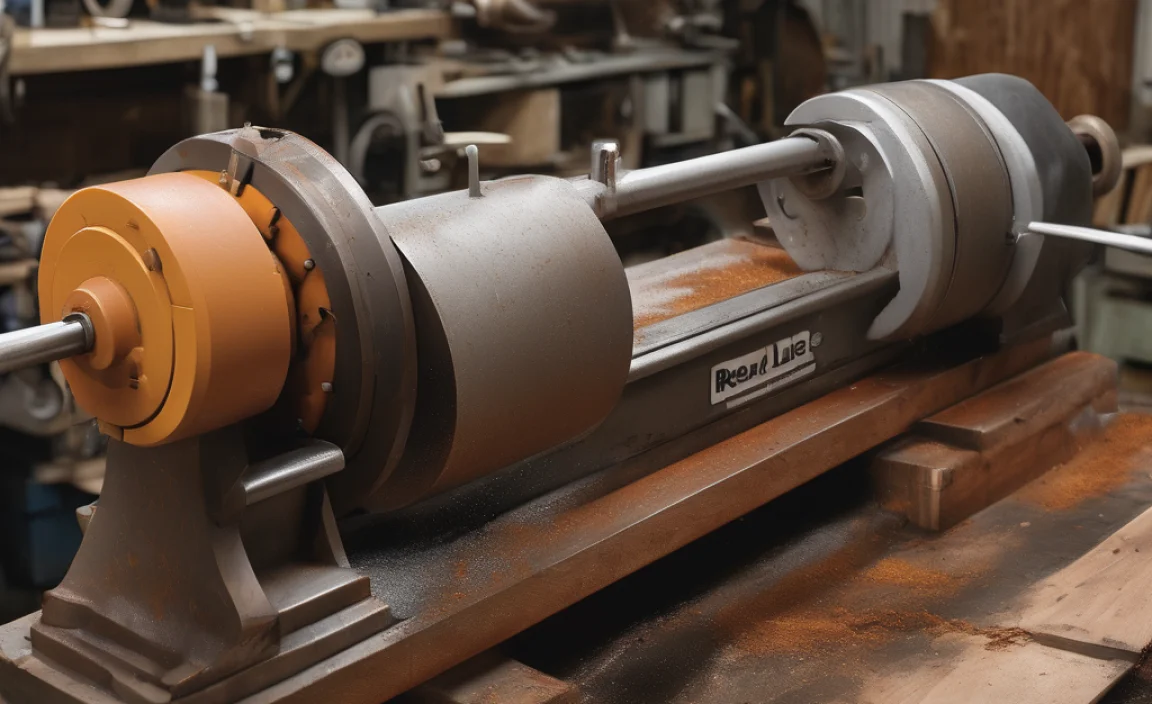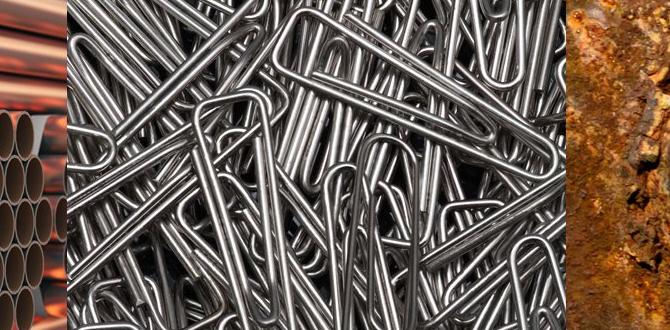A 1/4 inch carbide end mill is a vital cutting tool for machining tough materials like tool steels. Understanding its specifications, such as length and flute count, helps select the right one for precise cuts in your milling projects.
Welcome to Lathe Hub! Ever stared at a collection of end mills, wondering which one is the magic wand for your specific metalworking task? You’re not alone! When it comes to tackling tougher materials like tool steels, choosing the right 1/4 inch carbide end mill can feel like a puzzle. But don’t worry, we’ll break it down so you can confidently pick the perfect tool for a clean, efficient cut. We’ll explore what makes these small but mighty tools so effective and how to choose the best one for your needs, especially when working with stubborn steels.
What is a Carbide End Mill?
An end mill is a type of milling cutter, a cutting tool used in milling operations. Think of it as a drill bit that can also cut sideways. Unlike a drill bit that primarily makes holes, an end mill can move horizontally into a workpiece, shave off material, and create complex shapes, slots, and profiles. They are used in a wide variety of machining applications, from simple roughing to intricate finishing.
The “carbide” in carbide end mill refers to the material it’s made from: cemented carbide. This is an extremely hard and durable composite material made from fine particles of tungsten carbide and a binder metal, usually cobalt. This hardness is what makes carbide end mills so effective at cutting tougher metals and maintaining their sharp edge for longer periods compared to their high-speed steel (HSS) counterparts.
Why 1/4 Inch Carbide End Mills are Essential for Tool Steels
Tool steels are a class of carbon and alloy steels known for their exceptional hardness, wear resistance, and ability to hold a cutting edge. They are used to manufacture cutting tools, dies, and molds. Machining tool steel with conventional cutters can be slow and challenging, leading to premature tool wear and poor surface finish. This is where a 1/4 inch carbide end mill shines.
Key advantages of using carbide end mills for tool steel:
- Hardness: Cemented carbide is significantly harder than high-speed steel, allowing it to cut efficiently through hardened tool steels without rapidly dulling.
- Heat Resistance: Carbide tools can withstand higher cutting temperatures generated when machining tough materials, preventing them from softening and losing their cutting ability.
- Rigidity: Carbide offers excellent rigidity, which helps in maintaining dimensional accuracy and a good surface finish, even when taking deeper cuts or working with less rigid setups.
- Speed: Due to their hardness and heat resistance, carbide end mills can often be run at higher cutting speeds than HSS tools, leading to faster machining cycles.
- Tool Life: For the right application, carbide tools offer a significantly longer lifespan, reducing downtime and the frequency of tool changes.
The 1/4 inch size is particularly versatile. It’s small enough for detailed work and intricate features, yet substantial enough for removing material effectively in many common milling tasks. This size is often used for creating slots, pockets, profile milling, and edge breaks in a variety of workpieces, including those made from A2 tool steel and other common varieties.
Understanding the Specifications: What to Look For
When you’re ready to buy a 1/4 inch carbide end mill for tool steel, you’ll notice several specifications. Understanding these will help you choose the right tool for the job and avoid frustration.
Shank Diameter
This is straightforward: for a 1/4 inch end mill, the shank diameter will be 1/4 inch. This is the part of the end mill that fits into your milling machine’s collet or holder. Ensure your collet or tool holding system can accommodate this size.
Cutting Diameter
This is the diameter of the cutting edges. While the name often implies the cutting diameter matches the shank (e.g., a 1/4 inch end mill usually has a 1/4 inch cutting diameter), always confirm the exact cutting diameter in the product’s specifications, especially if you are cutting to a precise dimension.
Flute Count (Number of Flutes)
The flutes are the spiral grooves that run along the cutting end of the mill. They are crucial for chip evacuation (carrying away the material being cut) and engaging with the workpiece. The number of flutes impacts performance:
- 2 Flutes: These end mills offer more clearance for chips, making them excellent for slotting and pocketing operations, especially in softer materials or when deep cuts are required. They are also often used for general-purpose work.
- 3 Flutes: A good compromise between chip clearance and surface finish. They can handle a wider range of materials and operations than 2-flute mills and often provide a smoother finish.
- 4 Flutes: With less chip clearance, 4-flute end mills are best for finishing passes, providing a superior surface finish. They are generally not recommended for slotting or pocketing in materials that produce long, stringy chips, as they can pack up with material. However, they excel in harder materials where smaller chips are produced.
For machining tool steels, a 2 or 3-flute end mill is often preferred initially to manage chip evacuation effectively, especially if you’re not using a flood coolant or MQL (Minimum Quantity Lubrication) system. A 4-flute can be excellent for finishing passes once the bulk of the material is removed if chip evacuation isn’t an issue.
Helix Angle
The helix angle is the steepness of the flutes. Common helix angles are 30 degrees, 45 degrees, and 60 degrees. Some end mills also feature a variable helix angle.
- Standard Helix (approx. 30-45 degrees): Good all-around performance for general milling.
- High Helix (approx. 60 degrees): Provides a shearing action that results in a smoother cut and better surface finish. They also help in clearing chips more effectively due to their steeper angle. High helix tools are often very rigid but can be more prone to chatter in less rigid setups.
For tough materials like tool steel, a higher helix angle (like 45-60 degrees) can often be beneficial, providing a cleaner cut and better chip evacuation. However, always consider the rigidity of your machine and setup.
Length (Overall Length and Cutting Length)
End mills come in various lengths:
- Standard Length: Offers a good balance of rigidity and reach.
- Stub Length: Shorter overall length and cutting length. These are very rigid and minimize deflection, making them excellent for heavy-duty cuts, deep accounts, or when chatter is a problem. They are often a good choice for demanding materials like tool steel where rigidity is paramount. A 1/4 inch shank stub length end mill will be very robust.
- Extended Length: Provides a longer reach for accessing deeper features or working on taller parts. However, they are less rigid and more prone to deflection and vibration.
When machining tool steel, especially with a smaller diameter like 1/4 inch, a stub length end mill can provide the necessary rigidity to prevent chatter and breakage and ensure accuracy.
Coating
Coatings are applied to the surface of the end mill to improve performance. For machining tool steels, several coatings are beneficial:
- Uncoated: The base carbide. Good for some applications but generally less effective than coated tools for hard materials.
- Bright (Uncoated): Standard for high-speed steel, less common for carbide.
- TiN (Titanium Nitride): A general-purpose coating that improves hardness and lubricity, offering some protection against heat and wear.
- TiCN (Titanium Carbonitride): A harder and more wear-resistant coating than TiN, offering better performance in abrasive materials and at higher speeds.
- TiAlN (Titanium Aluminum Nitride) / AlTiN (Aluminum Titanium Nitride): Excellent choices for high-temperature applications and machining hard steels. They form a protective oxide layer at elevated temperatures, providing superior heat resistance and extended tool life. These are often the go-to for tool steel machining.
- ZrN (Zirconium Nitride): Offers good lubricity and is often used for aluminum and non-ferrous materials, but also provides good performance in some ferrous applications.
For machining tool steel, AlTiN/TiAlN coatings are highly recommended due to their superior performance at high temperatures. Understanding end mill coatings can significantly enhance your machining results and tool longevity.
End Style
The shape of the cutting end determines the types of features you can create:
- Square End: The most common type. The end is flat and perpendicular to the axis, allowing for square shoulders, pockets, and the creation of 90-degree corners.
- Ball End: The end is hemispherical, allowing for the creation of rounded internal corners and contoured surfaces. Ideal for 3D profiling.
- Corner Radius: A flat end with a radiused corner. This adds a small radius to internal corners, increasing strength and reducing stress concentrations compared to a sharp square corner. This is often a good choice for tool steel as it reduces the risk of chipping at the corner.
For general machining of tool steel where you need to cut slots, pockets, or profiles, a square end or a corner radius end mill would be suitable. A corner radius is often preferred to avoid chipping the tool or workpiece at sharp internal corners.
Carbide End Mill 1/4 Inch: Tool Steels and Material Compatibility
When we talk about “tool steels,” we’re referring to a group of steels that are particularly hard and wear-resistant. These can be challenging to machine, but with the right tools, it’s very achievable.
A2 Tool Steel
A2 tool steel is a cold-work tool steel known for its excellent toughness, wear resistance, and good dimensional stability during heat treatment. It’s a popular choice for dies, punches, shear blades, and wear parts. A2 is considered moderately difficult to machine when annealed (softened for machining) and very difficult when hardened. A 1/4 inch carbide end mill is a great choice for milling A2, especially in its hardened state. Using an AlTiN/TiAlN coated end mill and appropriate cutting parameters is key here.
Other Tool Steels
Beyond A2, there are many other tool steels, each with its own properties:
- O1 Tool Steel: An oil-hardening tool steel, generally considered easier to machine than A2 but still requiring robust tooling.
- D2 Tool Steel: A high-carbon, high-chromium tool steel known for extreme wear resistance but can be brittle and difficult to machine; requires careful setup and robust tooling.
- S7 Tool Steel: A shock-resisting tool steel, known for high impact toughness. Machinable but requires appropriate tooling and speeds.
Regardless of the specific tool steel, always aim to machine it in its softest state (annealed) if possible. However, many applications require machining after hardening. In these cases, a high-quality carbide end mill with appropriate coatings and cutting strategies is non-negotiable.
MQL Friendly Carbide End Mills
MQL (Minimum Quantity Lubrication) is a machining technique that uses a very small amount of lubricating fluid, typically in an aerosolized mist, instead of a large volume of coolant. it is becoming increasingly popular due to its environmental benefits, cost savings, and improved surface finish in certain applications. MQL systems deliver a fine mist directly to the cutting zone.
Carbide end mills designed for MQL often have specific features:
- Internal Coolant Channels: While less common on smaller diameter end mills like 1/4 inch, larger MQL-specific end mills may have internal coolant channels. For 1/4 inch tools, effective external MQL delivery is more common.
- Specialized Coatings: Coatings like AlTiN/TiAlN are already high-temperature resistant and work well with MQL, as the mist provides some cooling and lubrication.
- Chip Breaker Grooves: Some MQL-friendly tools have chip breaker features on the flutes to help break chips into smaller, more manageable pieces, which is crucial when chip evacuation is optimized by the mist.
When using MQL with a 1/4 inch carbide end mill on tool steel, ensure your MQL system is properly calibrated to deliver the mist effectively. This helps to cool the cutting edge, lubricate the cut, and evacuate chips, all of which are vital for successful machining of hard materials.
Cutting Parameters for 1/4 Inch Carbide End Mills in Tool Steel
Setting the right cutting parameters (speed and feed) is crucial for performance, tool life, and safety when machining tool steel with a 1/4 inch carbide end mill. These are not hard and fast rules and will require adjustment based on your specific machine, tool, material condition, and setup rigidity. Always start conservatively and gradually increase as confidence and understanding grow.
A good starting point involves understanding Surface Speed (SFM or SMM) and Chip Load (CL).
- Surface Speed (SFM/SMM): This is the speed at which the cutting edge of the tool is moving across the material. Tungsten carbide tools can often run much faster than HSS. For carbide machining tool steel, speeds might range from 100-300 SFM (Surface Feet per Minute) or 30-90 SMM (Surface Meters per Minute), depending heavily on the coating, lubrication, and rigidity.
- Chip Load (CL): This is the thickness of the chip that each tooth of the end mill removes per revolution. For a 1/4 inch end mill working with tool steel, a starting chip load might be in the range of 0.001″ to 0.003″ (0.025mm to 0.075mm) per tooth. This value is highly dependent on the number of flutes and the specific material.
Calculating Spindle Speed (RPM):
Once you have a target Surface Speed (SFM) and know your tool diameter, you can calculate the required Spindle Speed (RPM).
RPM = (SFM × 12) / π × Diameter (inches)
RPM = (SMM × 1000) / π × Diameter (mm)
Example Calculation:
Let’s say you have a 1/4 inch (0.25 inch) AlTiN coated carbide end mill and you want to run at 200 SFM.
RPM = (200 SFM × 12) / (3.14159 × 0.25 inches) ≈ 3056 RPM
Now, using a target chip load of 0.0015″ per tooth and a 2-flute end mill:
Feed Rate (IPM – Inches Per Minute) = RPM × Number of Flutes × Chip Load
Feed Rate = 3056 RPM × 2 Flutes × 0.0015″ / Flute ≈ 9.17 IPM
These are just starting points. For tool steels, especially hardened ones, you will likely need to run at the lower end of speed ranges and with conservative chip loads, focusing on rigidity and lubrication.
Table: General Starting Parameters for 1/4″ Carbide End Mill in Tool Steel (Annealed)
Note: These are approximate starting points. Always consult tool manufacturer recommendations and test.
| Material Condition | Tool Type | Surface Speed (SFM) | Chip Load/Tooth (in) | Number of Flutes | Lubrication |
|---|---|---|---|---|---|
| Annealed Tool Steel (e.g., A2, O1) | 2 Flute, High Helix, AlTiN/TiAlN Coated | 150 – 250 | 0.001 – 0.003 | 2 | Flood Coolant or MQL |
| 3 Flute, High Helix, AlTiN/TiAlN Coated | 120 – 200 | 0.001 – 0.0025 | 3 | Flood Coolant or MQL |







